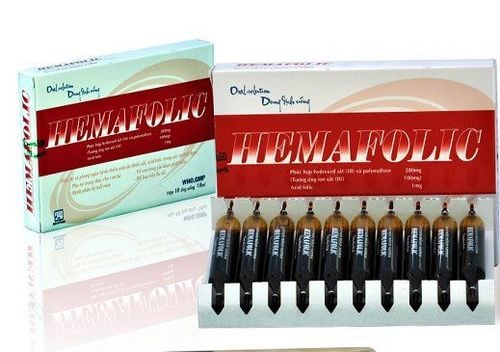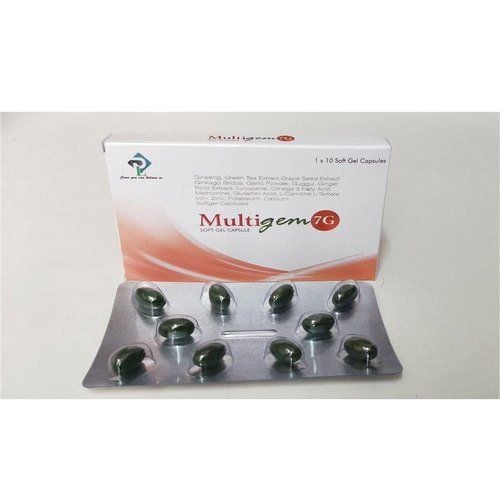This is an automatically translated article.
Saferon is available in the form of chewable tablets, drops or syrup. The drug has the main ingredient of iron, which helps to supplement or treat anemia and iron deficiency for the body.
1. Uses of Saferon
Saferon drug is prepared in the following forms:
1 chewable tablet contains: 100mg elemental iron and 500mcg folic acid; 1ml drops contains: 50mg elemental iron; 5ml syrup contains: 50mg elemental iron. All 3 drugs are iron tablets containing iron(III) hydroxide polymaltose complex. This is a stable complex, safe, less irritating to the stomach, well tolerated and less interactive than common iron salts. Particularly, the chewable tablet form has folic acid (vitamin B9) which is an essential substance in many metabolic processes of the body.
Saferon is indicated in the following cases:
Prophylaxis and treatment of latent iron deficiency, iron deficiency anemia, iron deficiency. The subjects that often encounter this condition are: Women before, during, after pregnancy and breastfeeding; Children lack iron due to daily diet. The following groups of subjects are recommended contraindications to the use of Saferon:
People with hypersensitivity to the ingredients contained in the drug; Non-iron deficiency anemia: For example, erythropoiesis, hemolytic anemia, bone marrow hypoplasia; Iron overload syndrome or iron overload; Diseases of iron assimilation or iron storage.
2. How to use and dose Saferon
Depending on the degree of iron deficiency, the dose and duration of medication will be different for each person. The daily dose can be taken once or in divided doses.
2.1 Saferon tablet form How to use: Take the tablet whole or chew, drink after eating for the best effect.
Reference dosages are as follows:
Children under 12 years old but old enough to swallow the whole pill: Take a dose of 1⁄2 - 1 tablet/day; Children over 12 years old and adults: Take 1-2 tablets/day; Pregnant women: Take 2-3 tablets/day. Prophylaxis of iron deficiency anemia: Use dose 1⁄2 - 1 tablet/day. When the hemoglobin value returns to normal, it is necessary to continue treatment for another 3 months to replenish the body's iron stores.
2.2 Saferon drops How to use: Take Saferon drops during or after eating. The medicine can be mixed with food or vegetable or fruit juice before giving it to the child.
Reference dosage is as follows:
Premature babies: Use 1-2 drops/kg/day for 3 - 5 months if there is obvious iron deficiency; Children under 1 year old: Use dose 10 - 20 drops/day if there is obvious iron deficiency; 6 - 10 drops/day if latent iron deficiency; 2-4 drops/day for prophylaxis; Children 1 - 12 years old: Use a dose of 20 - 40 drops/day if there is obvious iron deficiency; 10-20 drops/day if latent iron deficiency; 4-6 drops/day for prophylaxis. If there is a marked iron deficiency, treatment should be given for the next 3-5 months when the hemoglobin value returns to normal. After that, treatment should be continued for a few more weeks with the indicated dose for latent iron deficiency in order to replenish the body's iron stores.
2.3 Saferon syrup form How to use: Take the syrup during or immediately after eating.
Reference dosage is as follows:
Children under 1 year old: Use dose 2.5 - 5ml/day if there is obvious iron deficiency; Children from 1 to 12 years old: Use dose 5 - 10ml/day if there is obvious iron deficiency; 2.5 - 5ml/day if latent iron deficiency; Children over 12 years old, adults and lactating women: Use dose 10 - 20ml/day if there is obvious iron deficiency; 5-10ml/day if latent iron deficiency; Pregnant women: Use a dose of 20 - 30ml/day if there is obvious iron deficiency; 10ml/day if latent iron deficiency; 5-10ml/day if prophylactic treatment. If there is a marked iron deficiency, treatment should be given for 3 - 5 months until the hemoglobin value returns to normal. After that, treatment should be continued for a few more weeks with doses for latent iron deficiency to replenish the body's iron stores.
There are currently no reports of an overdose of Saferon. Symptoms of iron overdose include: Nausea, vomiting, abdominal pain, fatigue, tarry stools, weakness, rapid pulse, fever, coma, convulsions, death,... Folic acid is a water-soluble vitamin, Safe at high doses, very low risk of toxicity. If an iron overdose occurs, the patient needs immediate emergency treatment for prompt treatment and support.
3. Saferon drug side effects
Side effects from Saferon are very rare. Side effects, if any, include: Gastrointestinal disturbances (nausea, vomiting, epigastric pain, metallic taste in the mouth, constipation, black stools, diarrhea) or hypersensitivity reactions. Gastrointestinal side effects, if evidenced, can be minimized by taking the drug with food and after food. When experiencing side effects of Saferon, patients should notify their doctor immediately.
4. Saferon drug interactions
Drug interactions with Saferon have not been observed. Iron tablets are in complex form, so there is almost no interaction between iron ions with:
Some substances in food: Oxalate, tannin, phytin,...; Antibiotics of the group tetracycline, chloramphenicol, fluoroquinolone; Antacids such as cimetidine; Other drugs: Methotrexate, phenytoin, levodopa, levothyroxine. Note: Folic acid deficiency can be caused by antiepileptic drugs, anti-tuberculosis drugs, alcohol, oral contraceptives, folic acid antacids (such as pyrimethamine, triamterene, methotrexate, trimethoprim and sulfonamide).
To avoid possible drug interactions, Saferon should be taken at least 2 hours apart from other drugs and should immediately notify the doctor about the drugs you are using.
Saferon contains many substances necessary for the body. However, users need to be careful when using the drug, strictly follow the doctor's instructions. If there are any questions that need to be answered, users should directly ask a doctor for specific advice.
Please dial HOTLINE for more information or register for an appointment HERE. Download MyVinmec app to make appointments faster and to manage your bookings easily.













